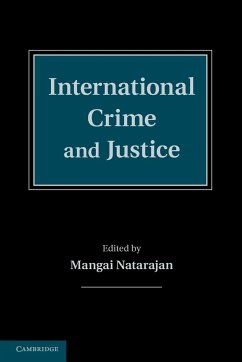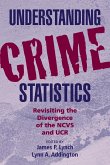International Crime and Justice
Herausgeber: Natarajan, Mangai
International Crime and Justice
Herausgeber: Natarajan, Mangai
- Broschiertes Buch
- Merkliste
- Auf die Merkliste
- Bewerten Bewerten
- Teilen
- Produkt teilen
- Produkterinnerung
- Produkterinnerung
This book examines the field of global international crime and justice, providing an introduction to the nature of international and transnational crimes.
Andere Kunden interessierten sich auch für
![Urbanization and Crime Urbanization and Crime]() Eric A. JohnsonUrbanization and Crime35,99 €
Eric A. JohnsonUrbanization and Crime35,99 €![The Explanation of Crime The Explanation of Crime]() The Explanation of Crime55,99 €
The Explanation of Crime55,99 €![Legacies of Crime Legacies of Crime]() Peggy C. GiordanoLegacies of Crime37,99 €
Peggy C. GiordanoLegacies of Crime37,99 €![The Causes of Crime The Causes of Crime]() Sarnoff A. MednickThe Causes of Crime55,99 €
Sarnoff A. MednickThe Causes of Crime55,99 €![Understanding Crime Statistics Understanding Crime Statistics]() James P. Lynch / Lynn A. Addington (eds.)Understanding Crime Statistics50,99 €
James P. Lynch / Lynn A. Addington (eds.)Understanding Crime Statistics50,99 €![American Criminal Justice Policy American Criminal Justice Policy]() Daniel P. MearsAmerican Criminal Justice Policy44,99 €
Daniel P. MearsAmerican Criminal Justice Policy44,99 €![Crime and Repression in the Auvergne and the Guyenne, 1720-1790 Crime and Repression in the Auvergne and the Guyenne, 1720-1790]() Iain A. CameronCrime and Repression in the Auvergne and the Guyenne, 1720-179030,99 €
Iain A. CameronCrime and Repression in the Auvergne and the Guyenne, 1720-179030,99 €-
-
-
This book examines the field of global international crime and justice, providing an introduction to the nature of international and transnational crimes.
Produktdetails
- Produktdetails
- Verlag: Cambridge University Press
- Seitenzahl: 570
- Erscheinungstermin: 8. November 2011
- Englisch
- Abmessung: 229mm x 152mm x 33mm
- Gewicht: 914g
- ISBN-13: 9780521144490
- ISBN-10: 0521144493
- Artikelnr.: 34743210
- Herstellerkennzeichnung
- Libri GmbH
- Europaallee 1
- 36244 Bad Hersfeld
- gpsr@libri.de
- Verlag: Cambridge University Press
- Seitenzahl: 570
- Erscheinungstermin: 8. November 2011
- Englisch
- Abmessung: 229mm x 152mm x 33mm
- Gewicht: 914g
- ISBN-13: 9780521144490
- ISBN-10: 0521144493
- Artikelnr.: 34743210
- Herstellerkennzeichnung
- Libri GmbH
- Europaallee 1
- 36244 Bad Hersfeld
- gpsr@libri.de
List of figures and tables
List of contributors
Foreword
Preface
Introduction
Part I. International Criminology: 1. The globalization of crime
2. Routine activities and transnational crime
3. Migration and crime
4. Political violence: a criminological analysis
5. Victimology: services and rights for victims of domestic and international crimes
6. Children and international criminal justice
7. Women and international criminal justice
8. Culture and crime
Part II. Law, Punishment, and Crime Control Philosophies of the World: 9. Legal traditions
10. Punishment philosophies and practices around the world
11. Crossnational measures of punitiveness
12. Prisons around the world
13. Crime prevention in an international context
Part III: Transnational Crime: 14. Drug trafficking
15. Understanding trafficking in human beings: a human rights, public health, and criminal justice issue
16. International trafficking of stolen vehicles
17. Transnational firearms trafficking: guns for crime and conflict
18. Trafficking antiquities
19. The illegal cigarette trade
20. Cybercrime
21. International fraud
22. Money laundering
23. Child pornography
24. Maritime crime
25. Transnational environmental crime
26. The Bhopal gas disaster and corporate criminal negligence
27. Endangered species markets: a focus for criminology?
28. Corruption
29. Tourist and visitor crime
Part IV. Organized Crime and Terrorism: 30. Transnational organized crime
31. The rise of Balkan organized crime
32. Russian organized crime
33. The Italian Mafia
34. Extortion and organized crime
35. Organized crime in Asia
36. Drug cartels: neither holy, nor Roman, nor an empire
37. The international implications of domestic terrorism in the United States
38. Terrorism
Part V. International Crime: 39. Genocide, war crimes, and crimes against humanity
40. History of genocide
41. Apartheid: a crime against humanity
42. War crimes
43. The crime of aggression
Part VI. Delivering International Justice: 44. The role of the United Nations
45. Treaties and international law
46. International criminal tribunals and hybrid courts
47. The International Criminal Court
48. The ICC and the Darfur investigation: progress and challenges
49. Victims' rights in the International Criminal Court (ICC)
50. Nongovernmental organizations and international criminal justice
51. Global and regional human rights commissions
52. The truth and reconciliation commission in South Africa
53. The Guatemalan Truth Commission: genocide through the lens of transitional justice
Part VII. International Cooperation and Criminal Justice: 54. World policing models
55. Crossborder policing
56. Challenge and transition: policing developments in the European criminal justice system
57. The European Union and judicial cooperation
58. The longer arm of the law: the growth and limits of international law enforcement and criminal justice cooperation
59. International cooperation to combat money laundering
Part VIII. International Research and Crime Statistics: 60. The US Uniform Crime Reports and the National Crime Victimization Survey
61. Highlights of the International Crime Victims Survey
62. Crossnational comparisons based on official statistics of crime
63. The International Self-Report Delinquency Study (ISRD)
64. Criminology, method, and qualitative comparative analysis
Part IX. International Research Resources: 65. International criminal justice: printed and electronic media, journals, and professional associations
66. World Criminal Justice Library Network
World map
Index.
List of contributors
Foreword
Preface
Introduction
Part I. International Criminology: 1. The globalization of crime
2. Routine activities and transnational crime
3. Migration and crime
4. Political violence: a criminological analysis
5. Victimology: services and rights for victims of domestic and international crimes
6. Children and international criminal justice
7. Women and international criminal justice
8. Culture and crime
Part II. Law, Punishment, and Crime Control Philosophies of the World: 9. Legal traditions
10. Punishment philosophies and practices around the world
11. Crossnational measures of punitiveness
12. Prisons around the world
13. Crime prevention in an international context
Part III: Transnational Crime: 14. Drug trafficking
15. Understanding trafficking in human beings: a human rights, public health, and criminal justice issue
16. International trafficking of stolen vehicles
17. Transnational firearms trafficking: guns for crime and conflict
18. Trafficking antiquities
19. The illegal cigarette trade
20. Cybercrime
21. International fraud
22. Money laundering
23. Child pornography
24. Maritime crime
25. Transnational environmental crime
26. The Bhopal gas disaster and corporate criminal negligence
27. Endangered species markets: a focus for criminology?
28. Corruption
29. Tourist and visitor crime
Part IV. Organized Crime and Terrorism: 30. Transnational organized crime
31. The rise of Balkan organized crime
32. Russian organized crime
33. The Italian Mafia
34. Extortion and organized crime
35. Organized crime in Asia
36. Drug cartels: neither holy, nor Roman, nor an empire
37. The international implications of domestic terrorism in the United States
38. Terrorism
Part V. International Crime: 39. Genocide, war crimes, and crimes against humanity
40. History of genocide
41. Apartheid: a crime against humanity
42. War crimes
43. The crime of aggression
Part VI. Delivering International Justice: 44. The role of the United Nations
45. Treaties and international law
46. International criminal tribunals and hybrid courts
47. The International Criminal Court
48. The ICC and the Darfur investigation: progress and challenges
49. Victims' rights in the International Criminal Court (ICC)
50. Nongovernmental organizations and international criminal justice
51. Global and regional human rights commissions
52. The truth and reconciliation commission in South Africa
53. The Guatemalan Truth Commission: genocide through the lens of transitional justice
Part VII. International Cooperation and Criminal Justice: 54. World policing models
55. Crossborder policing
56. Challenge and transition: policing developments in the European criminal justice system
57. The European Union and judicial cooperation
58. The longer arm of the law: the growth and limits of international law enforcement and criminal justice cooperation
59. International cooperation to combat money laundering
Part VIII. International Research and Crime Statistics: 60. The US Uniform Crime Reports and the National Crime Victimization Survey
61. Highlights of the International Crime Victims Survey
62. Crossnational comparisons based on official statistics of crime
63. The International Self-Report Delinquency Study (ISRD)
64. Criminology, method, and qualitative comparative analysis
Part IX. International Research Resources: 65. International criminal justice: printed and electronic media, journals, and professional associations
66. World Criminal Justice Library Network
World map
Index.
List of figures and tables
List of contributors
Foreword
Preface
Introduction
Part I. International Criminology: 1. The globalization of crime
2. Routine activities and transnational crime
3. Migration and crime
4. Political violence: a criminological analysis
5. Victimology: services and rights for victims of domestic and international crimes
6. Children and international criminal justice
7. Women and international criminal justice
8. Culture and crime
Part II. Law, Punishment, and Crime Control Philosophies of the World: 9. Legal traditions
10. Punishment philosophies and practices around the world
11. Crossnational measures of punitiveness
12. Prisons around the world
13. Crime prevention in an international context
Part III: Transnational Crime: 14. Drug trafficking
15. Understanding trafficking in human beings: a human rights, public health, and criminal justice issue
16. International trafficking of stolen vehicles
17. Transnational firearms trafficking: guns for crime and conflict
18. Trafficking antiquities
19. The illegal cigarette trade
20. Cybercrime
21. International fraud
22. Money laundering
23. Child pornography
24. Maritime crime
25. Transnational environmental crime
26. The Bhopal gas disaster and corporate criminal negligence
27. Endangered species markets: a focus for criminology?
28. Corruption
29. Tourist and visitor crime
Part IV. Organized Crime and Terrorism: 30. Transnational organized crime
31. The rise of Balkan organized crime
32. Russian organized crime
33. The Italian Mafia
34. Extortion and organized crime
35. Organized crime in Asia
36. Drug cartels: neither holy, nor Roman, nor an empire
37. The international implications of domestic terrorism in the United States
38. Terrorism
Part V. International Crime: 39. Genocide, war crimes, and crimes against humanity
40. History of genocide
41. Apartheid: a crime against humanity
42. War crimes
43. The crime of aggression
Part VI. Delivering International Justice: 44. The role of the United Nations
45. Treaties and international law
46. International criminal tribunals and hybrid courts
47. The International Criminal Court
48. The ICC and the Darfur investigation: progress and challenges
49. Victims' rights in the International Criminal Court (ICC)
50. Nongovernmental organizations and international criminal justice
51. Global and regional human rights commissions
52. The truth and reconciliation commission in South Africa
53. The Guatemalan Truth Commission: genocide through the lens of transitional justice
Part VII. International Cooperation and Criminal Justice: 54. World policing models
55. Crossborder policing
56. Challenge and transition: policing developments in the European criminal justice system
57. The European Union and judicial cooperation
58. The longer arm of the law: the growth and limits of international law enforcement and criminal justice cooperation
59. International cooperation to combat money laundering
Part VIII. International Research and Crime Statistics: 60. The US Uniform Crime Reports and the National Crime Victimization Survey
61. Highlights of the International Crime Victims Survey
62. Crossnational comparisons based on official statistics of crime
63. The International Self-Report Delinquency Study (ISRD)
64. Criminology, method, and qualitative comparative analysis
Part IX. International Research Resources: 65. International criminal justice: printed and electronic media, journals, and professional associations
66. World Criminal Justice Library Network
World map
Index.
List of contributors
Foreword
Preface
Introduction
Part I. International Criminology: 1. The globalization of crime
2. Routine activities and transnational crime
3. Migration and crime
4. Political violence: a criminological analysis
5. Victimology: services and rights for victims of domestic and international crimes
6. Children and international criminal justice
7. Women and international criminal justice
8. Culture and crime
Part II. Law, Punishment, and Crime Control Philosophies of the World: 9. Legal traditions
10. Punishment philosophies and practices around the world
11. Crossnational measures of punitiveness
12. Prisons around the world
13. Crime prevention in an international context
Part III: Transnational Crime: 14. Drug trafficking
15. Understanding trafficking in human beings: a human rights, public health, and criminal justice issue
16. International trafficking of stolen vehicles
17. Transnational firearms trafficking: guns for crime and conflict
18. Trafficking antiquities
19. The illegal cigarette trade
20. Cybercrime
21. International fraud
22. Money laundering
23. Child pornography
24. Maritime crime
25. Transnational environmental crime
26. The Bhopal gas disaster and corporate criminal negligence
27. Endangered species markets: a focus for criminology?
28. Corruption
29. Tourist and visitor crime
Part IV. Organized Crime and Terrorism: 30. Transnational organized crime
31. The rise of Balkan organized crime
32. Russian organized crime
33. The Italian Mafia
34. Extortion and organized crime
35. Organized crime in Asia
36. Drug cartels: neither holy, nor Roman, nor an empire
37. The international implications of domestic terrorism in the United States
38. Terrorism
Part V. International Crime: 39. Genocide, war crimes, and crimes against humanity
40. History of genocide
41. Apartheid: a crime against humanity
42. War crimes
43. The crime of aggression
Part VI. Delivering International Justice: 44. The role of the United Nations
45. Treaties and international law
46. International criminal tribunals and hybrid courts
47. The International Criminal Court
48. The ICC and the Darfur investigation: progress and challenges
49. Victims' rights in the International Criminal Court (ICC)
50. Nongovernmental organizations and international criminal justice
51. Global and regional human rights commissions
52. The truth and reconciliation commission in South Africa
53. The Guatemalan Truth Commission: genocide through the lens of transitional justice
Part VII. International Cooperation and Criminal Justice: 54. World policing models
55. Crossborder policing
56. Challenge and transition: policing developments in the European criminal justice system
57. The European Union and judicial cooperation
58. The longer arm of the law: the growth and limits of international law enforcement and criminal justice cooperation
59. International cooperation to combat money laundering
Part VIII. International Research and Crime Statistics: 60. The US Uniform Crime Reports and the National Crime Victimization Survey
61. Highlights of the International Crime Victims Survey
62. Crossnational comparisons based on official statistics of crime
63. The International Self-Report Delinquency Study (ISRD)
64. Criminology, method, and qualitative comparative analysis
Part IX. International Research Resources: 65. International criminal justice: printed and electronic media, journals, and professional associations
66. World Criminal Justice Library Network
World map
Index.









